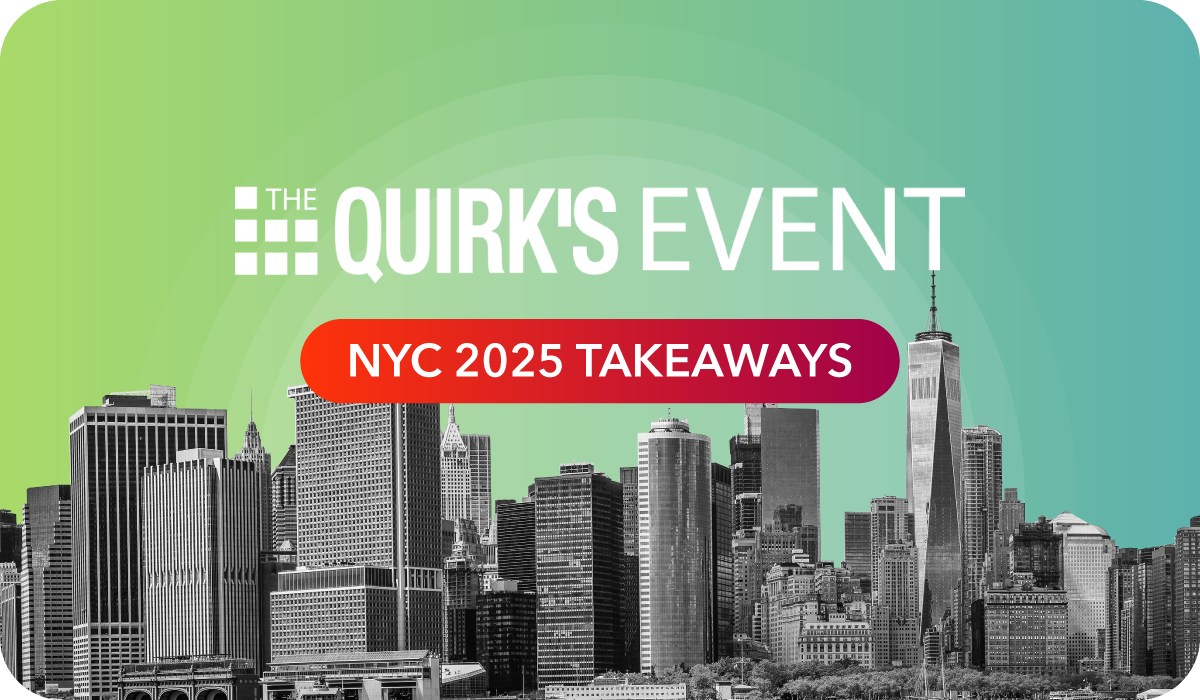Beyond the basics: Key themes from Quirk’s NYC on what’s next for consumer insights
Events • Jul 31, 2025 9:30:00 AM • Written by: Joe Corace

This year’s Quirk’s NYC conference offered more than just product updates and platform demos - it delivered a blueprint for how the insights function must evolve to meet a faster, more fragmented, and emotionally complex consumer landscape. As brands push to innovate, differentiate, and connect more deeply with audiences (especially Gen Z), the role of insights is expanding beyond validation to become a true partner in driving brand creation, shaping messaging, and even influencing culture.
Across sessions and hallways, several themes stood out - each signaling how the best-in-class are rethinking agility, collaboration, and the role of data in decision-making.
1. Collaboration is the new competitive advantage
Innovation is no longer just about having the best idea—it’s about bringing the right mix of people together to make that idea work.
One of the most resonant messages came from Eboni Washington (Suntory), who challenged traditional assumptions about innovation team composition. “Function and seniority are not the clear indicators of success,” she noted. Instead, her most productive teams shared an openness to challenge norms and a willingness to co-create without ego.
In a separate session, Mondelēz proved this point on a broader scale by pulling together its top 15 agency partners, traditionally siloed, to co-design new testing frameworks. The result? Deeper insights, faster decisions, and a new sense of shared purpose between supplier and client.
The takeaway: Internal or external, collaboration is no longer a “nice to have”—it’s the unlock for commercial and creative breakthroughs.
2. Agility isn’t about speed—it’s about responsiveness
There’s a growing realization that “agile” isn’t synonymous with “fast.”
In fact, some of the most agile brands showcased how rigor and flexibility can - and must - coexist.
At Estee Lauder, for instance, agility meant integrating foundational claims work upstream so teams weren’t scrambling post-launch to retro-fit messages. At Kenvue, agility showed up as behavior-based auction testing with Veylinx to understand which product claims actually moved consumers to pay, rather than relying on inflated attitudinal measures. And Nestlé’s R+D Accelerator demonstrated how six-month internal innovation sprints - backed by virtual behavioral testing - could balance pace with purpose.
Across all of these examples, agility wasn’t about skipping steps; it was about sequencing insights better, listening faster, and staying flexible without compromising the core integrity of the research.
3. Behavioral and synthetic data are expanding—but still have boundaries
From Hormel’s parallel testing with synthetic survey takers to PepsiCo’s behavioral framework for post-launch innovation tracking, it’s clear the tools available to insights professionals are expanding rapidly.
Synthetic data, in particular, drew attention for its ability to simulate responses with high fidelity and speed.
But while these tools hold promise, the consensus was clear: they complement human data, not replace it. The nuance, emotion, and context provided by real users—especially in categories driven by personal values or rituals—still matter deeply. As Stan Sthanunathan reminded us in his session on AI and human intimacy, “AI can get you 70% of the way there. Human oversight closes the gap.”
4. Gen Z’s “adulting” journey is shaping the future of brand engagement
If brands are still speaking to Gen Z as if they’re kids with credit cards, they’re missing the mark.
One of the most powerful sessions came from MarketVision's study on Gen Z’s transition into adulthood - revealing how this generation is rewriting the rules while still chasing familiar aspirations like home ownership and financial stability.
What stood out was the emotional complexity of this life stage: imposter syndrome, financial anxiety, and the overwhelming nature of “always-on” digital life. But there’s opportunity, too. Gen Z wants brands that are more than functional—they want brands to be progress partners, decision curators, and confidence builders. Tools like Intuit were spotlighted for helping this cohort navigate adulthood with clarity and support.
The call to action? Don’t just market to Gen Z. Show up for them in ways that earn trust, reduce friction, and amplify their momentum. With an average age of 28, they now have buying power, and what was once an aspirational target is now one that will impact brands for years to come.
5. The say–do gap isn’t just a research problem—it’s a business risk
Across nearly every session, a familiar theme echoed: what consumers say and what they do are not always aligned.
But more importantly, organizations that build this understanding into their frameworks are seeing stronger business results.
From Haleon and QualSights’ in-the-moment XMOT™ methodology to Numerator’s integration of sentiment with verified purchase behavior, the move is clear: brand health, innovation success, and claim effectiveness must all be grounded in actual behavior.
Whether through sensor-enabled packaging, AI-powered trend forecasting, or longitudinal behavioral data, the leading insight teams are finding ways to close this gap and bring commercial teams along for the ride.
Final thought: from insights to impact
The Quirk’s NYC experience made it clear: the future of insights is less about reporting and more about orchestration.
Orchestrating functions across R&D, Marketing, and Sales. Orchestrating signals across human and synthetic data. Orchestrating actions across strategy, activation, and innovation.
When done right, insights don’t just inform. They inspire. They build trust, speed, and differentiation - both inside organizations and in the lives of consumers.
Let’s not settle for getting the basics right. Let’s push to make insight the catalyst for brand transformation.
Ready to commit?
Joe Corace
Joe is a seasoned consumer insights executive with two decades of experience driving growth and innovation across global markets. His expertise spans multiple sectors, including consumer packaged goods, alcoholic beverages, retail, financial services, and healthcare. He currently serves as Orchard’s Chief Customer Officer. Widely recognized for his strategic acumen, Joe has consistently delivered actionable insights that inform C-suite decision-making for many Fortune 100 companies. He is also known for cultivating and expanding high-value client relationships, leading transformative sales strategies, and unlocking long-term value for both external clients and internal shareholders. Most recently, Joe served as Senior Vice President at Behaviorally, where he was tapped to lead the revitalization of the Midwest Region. In this role, he oversaw client acquisition, market expansion, and retention - transforming the office into a high-performing, multi-million-dollar operation. Earlier in his career, Joe held client leadership roles at top-tier firms including Kantar (Millward Brown), Nielsen (BASES), Maru/Matchbox, and Verve, where he consistently delivered commercial impact through customer-centric insight and innovation.
